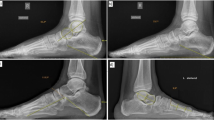Abstract
The purpose was to evaluate the value of radiology to distinguish between symptomatic and asymptomatic flexible flatfeet in young male adults. Among young male army recruits, 56 feet of 28 recruits were diagnosed as otherwise normal, flexible flatfoot with invisible longitudinal arch on stance and either symptomatic or asymptomatic unilaterally or bilaterally. The talus-first metatarsal and calcaneal pitch angles were measured on weight-bearing lateral radiographs, and the results were evaluated statistically. The talus-first metatarsal angle showed statistical significance in both non-parametric and logistic regression tests, but the calcaneal pitch angle showed statistical significance only in non-parametric test between symptomatic and asymptomatic flatfoot groups. Although the single gender and number of samples limit the applicability of our study, these results caused us to make an interpretation that increased talus-first metatarsal angle might be an important risk factor of being symptomatic in otherwise normal flexible flatfoot.
Résumé
Le but de cette étude est d’évaluer la valeur de la radio dans les pieds plats d’adultes jeunes qu’il soit symptomatique ou asymptomatique.Matériel et méthode : parmi des sujets recrutés dans l’armée, 56 pieds sur 28 recrues ont été considérés comme plats avec ou sans symptômes, qu’ils soient uni ou bilatéraux. L’angle astragale premier métatarse et le calcanéum a été mesuré en charge sur des radiographies de profil.Résultats : cet angle a une valeur significative seulement dans le test non paramétrique entre le groupe des pieds plats symptomatiques et des pieds plats asymptomatiques.Conclusion : ces résultats nous permettent de penser que l’aggravation de cet angle est un important facteur de risques d’évolution symptomatique chez les sujets avec pieds plats normaux, asymptomatiques.


Similar content being viewed by others
References
Abdel-Fattah MM, Hassanin MM, Felembane FA, Nassaane MT (2006) Flat foot among Saudi Arabian army recruits: prevalence and risk factors. East Mediterr Health J 12:211–217
Buerk AA, Albert MC (2001) Advances in pediatric foot and ankle treatment. Curr Opin Orthop 12:437–442
Chen CH, Huang MH, Chen TW, Weng MC, Lee CL, Wang GJ (2006) The correlation between selected measurements from footprint and radiograph of flatfoot. Arch Phys Med Rehabil 87:235–240
Esterman A, Pilotto L (2005) Foot shape and its effect on functioning in Royal Australian Air Force recruits. Part 1: Prospective cohort study. Mil Med 170:623–628
Esterman A, Pilotto L (2005) Foot shape and its effect on functioning in Royal Australian Air Force recruits. Part 2: Pilot, randomized, controlled trial of orthotics in recruits with flat feet. Mil Med 170:629–633
Herring JA (2002) Flexible flatfoot (Pes planovalgus). In: Herring JA (ed) Tachdjian’s Pediatric Orthopaedics. WB Saunders, Philadelphia, pp 908–921
Kanatli U, Yetkin H, Cila E (2001) Footprint and radiographic analysis of the feet. J Pediatr Orthop 21:225–228
Lee MS, Vanore JV, Thomas JL, Catanzariti AR, Kogler G, Kravitz SR, Miller SJ, Gassen SC (2005) Diagnosis and treatment of adult flatfoot. J Foot Ankle Surg 44:78–113
Lin CJ, Lai KA, Kuan TS, Chou YL (2001) Correlating factors and clinical significance of flexible flatfoot in preschool children. J Pediatr Orthop 21:378–382
Younger AS, Sawatzky B, Dryden P (2005) Radiographic assessment of adult flatfoot. Foot Ankle Int 26:820–825
Author information
Authors and Affiliations
Corresponding author
Rights and permissions
About this article
Cite this article
Pehlivan, O., Cilli, F., Mahirogullari, M. et al. Radiographic correlation of symptomatic and asymptomatic flexible flatfoot in young male adults. International Orthopaedics (SICOT) 33, 447–450 (2009). https://doi.org/10.1007/s00264-007-0508-5
Received:
Revised:
Accepted:
Published:
Issue Date:
DOI: https://doi.org/10.1007/s00264-007-0508-5




